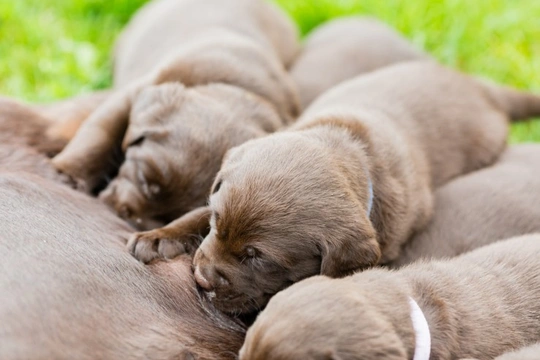
Did you know that puppies are born deaf?
Most dog lovers know that puppies are blind at birth, because their eyelids are sealed shut with a thin membrane of skin, which only breaks and so, lets them open their eyes to see during their second week of life. While the pups are very small, their dam will lick the eyes and faces of the puppies with her tongue, which not only stimulates the circulation and helps to keep the pups clean, but also, encourages their eyes to open up.
However, puppies are also born with their ear canals closed as well as their eyes-which means that puppies are effectively deaf when they are born, and again, will remain so up until they are anything up to around two to three weeks old!
In this article, we will explain in more detail why puppies cannot hear at birth, how to check their hearing development as they begin to develop this sense, and when you can expect a puppy to begin to hear properly. Read on to learn more.
Why can’t new-born puppies hear?
When puppies are born, their ear canals are closed-and will only begin to open later in their development. This does not make pups completely deaf, but they will only hear sounds very remotely and not clearly-like you might hear sounds if you were underwater in the bath or swimming pool.
As the pups develop, their ear canals open up naturally, allowing their hearing attenuation to grow until it reaches the optimum natural level.
Puppies actually need this level of quiet and distance from the normal sounds of the world while their ears continue to develop-until the ears have developed enough to process sound safely and comfortably, the ear canals will remain closed.
When our ears hear sounds, the sound waves cause finely-tuned shifts in pressure within the ear, and the movement of the various parts of the inner ear itself, and we are not even aware that this is happening-but if puppies are exposed to this stimulus before their ears have matured and developed sufficiently, it can cause pain and damage to the ear drums and inner ear, which may compromise the pup’s hearing later on.
A quiet environment for the dam to raise the pups and to permit the pups’ ears to develop until the point that the ear canal opens naturally is essential for healthy ear development and adult hearing.
Gestation, delivery and puppy development
The normal period of gestation for a dog ranges between 58 and 68 days, with around 62-63 days being the average. This is not a very long period of time in the greater scheme of things, and means that a lot of the development and growth that some other mammals complete in the womb must happen after delivery for dogs!
When it comes to mammals in general and how long they carry their young for prior to delivery, there can be a lot of variance between different species, and looking at the lifestyle and evolutionary history of each species can help to explain their respective periods of gestation.
For instance, dogs are not prey animals, and instead, hunt and scavenge for food without being the target of many natural predators, other than those that might opportunistically attack a dog that was injured or vulnerable. A pregnant dam cannot hunt and scavenge very effectively once her pregnancy is in the later stages, and so the sooner that she delivers, the sooner she can effectively hunt and nourish herself and her litter. Additionally, when she scavenges or hunts, she is apt to secure enough food for several days-meaning that she can hide her litter away for a few hours, go hunting, and come back with enough food to feed herself and provide nourishment for the pups while she raises them without having to go hunting again for some time.
However, the trade-off here is that the pups are helpless and still developing-they have no teeth at birth, nor can they see or hear, and they are even reliant on their dam to stimulate their bladder and bowel to pass waste. New-born puppies cannot walk upright either-but the dam will stand and protect them, in contrast to species of prey animals that rely on flight to get away from predators.
In comparison, cows carry their calves for around nine months-and when a calf is born, they are able to stand up within a few hours of birth, move around, and will be able to walk and run quickly, as well as having all of their senses intact. This works for bovines because cows are potential prey for other animals and rely on flight to stay safe-and so being well developed and ready to run from soon after delivery is essential to survival.
When do puppies start to hear?
The ear canals will usually begin to open up towards the end of the pup’s second week of life, and it takes another week or so from that point for their ear canals to have opened fully. You can actually see the opening of the ear canal itself, and so you can monitor your litter’s ears to see how the process is going, and so, judge when your pups are beginning to hear properly.
If the pups have reached three weeks old and their ear canals still appear closed and/or you are concerned that they cannot hear, talk to your vet for advice and to check that there is nothing amiss.



